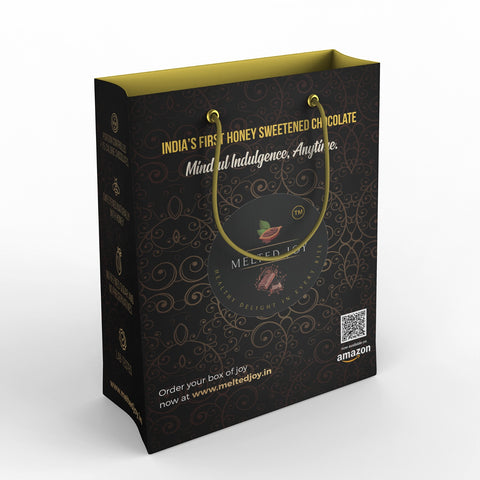
Where Consumers Go Wrong with "No Added Sugar" Chocolates
Share
Step into any supermarket aisle and you will see rows of chocolates flaunting the "No Added Sugar" tag.
Most people pick up a “No Added Sugar” chocolate bar believing it’s the healthier choice. After all, if sugar isn’t added, it must be guilt-free—right?
The reality is far less sweet. Behind the label lies a clever loophole in India’s food regulations: one that lets brands swap table sugar with other hidden sugars while still calling their product “No Added Sugar.”
The result? You’re eating just as many calories, sometimes even more.
At Melted Joy, we believe in transparency. So let us unpack why this label misleads and what you should actually be looking for.
The Loophole in FSSAI "No Added Sugar" Guidelines
According to the Food Safety and Standards Authority of India (FSSAI), brands can use the "No Added Sugar" claim if they do not add table sugar during manufacturing.
Sounds straightforward, right? Not quite. Here is where it gets misleading:
-
They can still add dates, raisins, dried fruit powders, fruit concentrates, malt extracts, or sugar alcohols.
-
All of these are concentrated sources of glucose or calories.
-
On paper, the label is technically correct. In reality, your body is still getting a heavy load of sugar.
This regulatory loophole allows brands to wrap their product in a “health halo.” You think you’re buying something safe for everyday snacking but you’re actually being misled.
What Does "Added Sugar" Really Mean?
Added sugars are those introduced during processing, cooking, or even at the table. This includes white sugar, brown sugar, jaggery, honey, syrups like glucose, corn, maple, agave, malt, golden, or rice syrup, along with fruit juice concentrates, cane juice, invert sugar, and refined forms such as dextrose, fructose, maltose, or sucrose.
So what actually qualifies as "No Added Sugar"?
According to food labeling rules, a product can make this claim if none of these sugars are added during manufacturing. It also cannot include ingredients that are primarily used for their sweetening properties, such as honey, malt, jaggery, syrups, or fruit juice concentrate.
Here’s the catch: the product can still naturally contain sugar from ingredients like fruits (dates, raisins, bananas, apples, figs), milk (lactose), cocoa solids (which naturally have a small amount of sugar), or even vegetables like beetroot, carrot, or sweet potato.
This is where the loophole shows up. A chocolate sweetened with dates or raisins instead of table sugar can still be marketed as "No Added Sugar," even though it may carry just as many calories from natural sugars. The label sounds reassuring, but the nutritional reality tells a very different story.
Hidden Calories in No Added Sugar Chocolates
Here is what most people do not realise:
-
A typical 80g "No Added Sugar" dark chocolate bar contains 500 to 550 calories
-
That is almost equal to a full meal: two rotis, dal, sabzi, and a spoon of ghee
The difference is in what those calories do:
-
A meal nourishes with protein, fibre, and satiety
-
The bar floods your system with sugar, leaves you hungry soon after, and sneaks in extra calories you did not plan for
So the next time you are tempted by a "guilt-free" chocolate bar, ask yourself: would you eat a second full meal just for dessert? Because that is essentially what is happening.
Why "No Added Sugar" Still Spikes Your Blood Sugar
Your body does not care if glucose comes from table sugar, dates, or fruit concentrates. Once digested, it all turns into the same thing: a blood sugar spike.
Here is the cycle:
-
Rapid blood sugar rise followed by a short-lived energy high
-
Insulin surge as your body scrambles to manage the sugar load
-
Crash and cravings which bring hunger back quickly and push you to overeat
Pair that with the false sense of security the label creates, and you often end up eating more than you would have with regular chocolate.
In other words, "No Added Sugar" does not just mislead, it can actively harm your eating habits.
How Melted Joy Does It Differently
We do not believe in playing games with loopholes. Our philosophy is simple: honesty over gimmicks.
Here is how Melted Joy stands apart:
-
Portion-controlled: Every bite is just 13g and under 75 calories. No oversized bars that push you into overeating
-
Sweetened with pure honey: No date paste, no fruit syrups, no sugar alcohols. Just the natural sweetness of honey
-
Lab transparency: Every product is third-party tested for nutrition facts, glycemic index, and heavy metals. You see exactly what you are eating
-
Indulgence without confusion: Chocolate that satisfies cravings without wrecking your calorie balance
We did not create Melted Joy to ride on buzzwords. We created it to bring chocolate back to what it should be, joyful honest indulgence.
The Takeaway
"No Added Sugar" is not a health badge, it is a loophole. What truly matters is:
-
Calories per bite
-
Ingredient transparency
When it comes to your health, labels can mislead but numbers do not lie.
At Melted Joy, our goal is simple: to help you enjoy chocolate without second-guessing. Because joy tastes sweeter when it is honest.
|
Final note: The next time you pick up a chocolate bar, do not just look at the front label. Flip it around. Read the calories. Check the portion size. That is where the truth really hides. |
FAQs
1. Is "No Added Sugar" chocolate really healthy?
Not necessarily. While it avoids table sugar, it often uses other high-calorie sweeteners like dates, fruit concentrates, or sugar alcohols. These can still spike blood sugar and add unnecessary calories.
2. What is the healthiest chocolate option?
The healthiest option is one that balances indulgence with portion control and transparency. Look for small servings, clear calorie counts, and natural sweeteners like honey.
3. Does honey raise blood sugar too?
Yes, honey is still a sugar, but it has a lower glycemic index than refined sugar and comes with trace antioxidants and minerals. When paired with portion control, it can be a better alternative.
